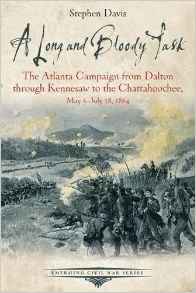A Long and Bloody Task: The Atlanta Campaign from Dalton through Kennesaw Mountain to the Chattahoochee River, May 5-July 18, 1864 by Stephen Davis. Savas Beatie, 2016. Paperback, ISBN: 978-1-61121-317-1. $14.95.
 The publisher Savas Beatie has undertaken an enormous intellectual challenge with its ongoing Emerging Civil War Series. The books in this series are short, compact, and aimed at introducing readers of all ages to the essentials of Civil War history, yet they are simultaneously nuanced, complex, and full of depth. Finding a balance between these sometimes contradictory goals is extremely difficult, and the series editors deserve praise for their good work. Stephen Davis’s A Long and Bloody Task is mostly successful in meeting the goals of the Emerging Civil War Series.
The publisher Savas Beatie has undertaken an enormous intellectual challenge with its ongoing Emerging Civil War Series. The books in this series are short, compact, and aimed at introducing readers of all ages to the essentials of Civil War history, yet they are simultaneously nuanced, complex, and full of depth. Finding a balance between these sometimes contradictory goals is extremely difficult, and the series editors deserve praise for their good work. Stephen Davis’s A Long and Bloody Task is mostly successful in meeting the goals of the Emerging Civil War Series.
A Long and Bloody Task explores the first phase of General William Tecumseh Sherman’s Atlanta Campaign in the summer of 1864. Davis’s overarching thesis is that Sherman’s successful movements toward Atlanta—and the eventual destruction of the city through federal cannonade and bombardment—were largely the fault of Confederate General Joseph E. Johnston’s inept generalship. Johnston’s inability to stop Sherman is the result of his overly defensive posture, his impulse to continually retreat towards Atlanta in the face of superior numbers, and a rapidly deteriorating relationship with Confederate political leaders in Richmond. His forces were in such a tenuous position by the time of his dismissal on July 18 that his successor, John Bell Hood, had little to no chance of preventing Sherman’s forces from eventually taking over Atlanta. Davis praises Hood as the unsung hero of the Confederate defense of Georgia, demonstrating in a brief historiographical essay at the end of the book how previous historians have wrongly tarnished his reputation.
Davis writes in a clear and concise manner that is easy to follow for readers, ranging from high school students to longtime Civil War enthusiasts. The narrative is complimented by an abundance of maps and photos, numerous appendices, a recommended reading list, and a comprehensive listing of the order of battle. The book even includes instructions for a driving tour through northern Georgia, highlighting notable landmarks worth visiting along the road to Atlanta. All of these contributions add to the book’s value and make it a worthwhile purchase for someone looking to begin their study of the Atlanta Campaign.
A Long and Bloody Task has its questionable interpretations, however. When primary source documents are cited, they are almost exclusively from the hands of Confederate soldiers, politicians, and supporters, leading to an unbalanced treatment of how each side planned for and reacted to changing circumstances on the battlefield (President Lincoln receives one mention in the entire book). General Sherman is portrayed as a blundering, insensitive leader whose greatest asset is his superiority in manpower. For example, Davis quotes a sentence from a letter Sherman wrote to his wife after the Battle of Kennesaw Mountain (“I begin to regard the death & mangling of a couple of thousand men as a small affair, a kind of morning dash”) and, in a moment of armchair psychology, suggests that this “callous” statement “may have been meant by Sherman as some perverse way of impressing his wife of his manliness” (75-76). The statement within the context of the letter paints a much different portrait. “It is enough to make the whole world start at the awful amount of death and destruction that stalks abroad,” Sherman recalls, pointing out that “each day is killed or wounded some valuable officers and men, the bullets coming from a concealed foe.” Sherman was no paragon of kindness, and he admits in this letter and several others that the deathly destruction of the campaign had “hardened” him. But explaining Sherman’s private thoughts on war as callously reflective of a sense of insecure masculinity is pure speculation at best.
Additionally, a brief but important analysis explaining the political context of the war is sorely missing from this book. The United States, even in 1864, was solely fighting a war to “conquer” the seceded Confederate states, according to Davis (1). Why these rebellious states attempted to leave the county in the first place goes completely unmentioned in the book.
Interpreting the politics of the Civil War is messy work, but it is necessary work even for a study largely focused on military matters. These omissions are unfortunate—especially in a book designed for beginners—because an avoidance of the complex moral questions that underlie a nation-state’s decision for war ultimately downplays the human costs incurred as a consequence of that decision. Was the Civil War merely a battle for territory between two political entities, or were there larger principles at stake in this deadly conflict? Readers will have to look elsewhere to find a satisfactory answer.
Nick Sacco is a Park Guide with the National Park Service at the Ulysses S. Grant National Historic Site.
